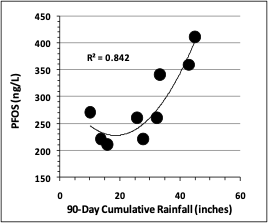What are PFAS?
Perfluoroalkyl substances (PFAS), also referred as perfluorinated compounds (PFC), have recently received attention as emerging contaminants in drinking water resources. PFAS are a family of complex manmade chemicals synthesized during the 1940s comprised of a fluorocarbon alkyl chain and a carboxylic or sulfonic acid group. They are resistant to heat, grease, and water degradation, which is why they can be found in numerous consumer and industrial products. A health advisory (HA) released in 2016 showed a constituent, perfluorooctanoic acid (PFOA), was detected in 99% of human serums in the U.S. between 1999 to 2012 as a persistent and bioaccumulating environmental compound.
What are PFAS?
Perfluoroalkyl substances (PFAS), also referred as perfluorinated compounds (PFC), have recently received attention as emerging contaminants in drinking water resources. PFAS are a family of complex manmade chemicals synthesized during the 1940s comprised of a fluorocarbon alkyl chain and a carboxylic or sulfonic acid group. They are resistant to heat, grease, and water degradation, which is why they can be found in numerous consumer and industrial products. A health advisory (HA) released in 2016 showed a constituent, perfluorooctanoic acid (PFOA), was detected in 99% of human serums in the U.S. between 1999 to 2012 as a persistent and bioaccumulating environmental compound.
PFAS Monitoring Between 2013-2015
PFAS monitoring between 2013 and 2015 examined six PFAS constituents in 4,900 Public Water Systems (PWS). PWS and the findings were published in the third Unregulated Contaminant Monitoring Rule (UCMR3). Perfluorooctane sulfonate (PFOS) and PFOA were most commonly encountered in all the sampled PWS. These compounds are no longer produced in the U.S., but traces of them can still be found in products coming from other places. The collective drinking water HA was recently revised by USEPA for both compounds, down from 200 ng/L to 70 ng/L. USEPA also requested appropriate remedial actions to be implemented by all public water agencies affected by the new ruling.
Contaminated Wells of Guam
The six contaminated wells of Guam are scattered across three regions: a) Tiyan, b) Chalan-Pago Ordot, and c) Hagåtña. Wells NAS-1, A-23 and A-25 are contaminated with PFOS over 70 ng/L. NAS-1, located in the former Naval Air Station Agana, was occupied by the U.S. Air Force from 1944 to 1995. About a year later of closing, volatile organic chemicals (VOC) were detected in NAS-1.

Dr. Denton, who is the retired WERI professor, analyzed a concentration pattern of PFOS from well A-25, the most contaminated well on Guam. PFOS data collected from June 2017 to January 2018, including three data sets from 2015 to 2016 obtained by GWA, were analyzed with cumulative precipitations recorded 30, 60, 90 and 120 days immediately prior to each sampling event. Second order polynomial regression analysis with a 90-day cumulative rainfall provided the best fit line to all PFOS-rainfall data plots. From these initial findings, variations in the duration and intensity of rain events over the preceding month seemed to have the greatest influence on this estimate, indicating that sources of PFASs may exist within some distance from well A-25.

PFAS contamination sites near well A-25 have not been identified. Thus, now WERI team is collecting soil and water samples from potential PFAS impacted sites. In collaboration with University of Rhode Island (Dr. Rainer Lohmann and Dr. Becanova), Dr. Barry Kim and Ms. Mallary Duenas are investigating the potential contamination sites.

